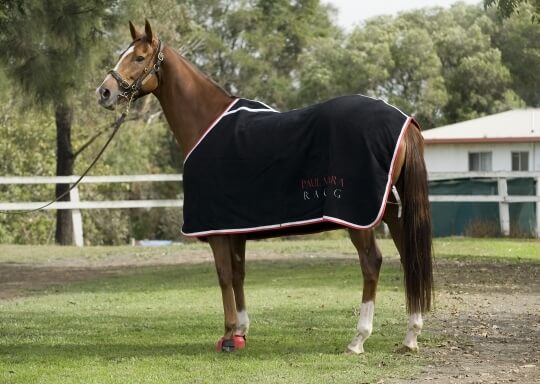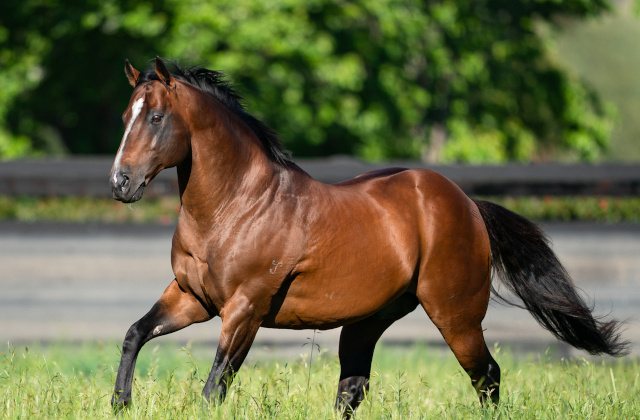The long journey to Royal Ascot

I’m on my way to London aboard this Qantas hotel in the sky they call an A380, with several items on my agenda, including cheering on Alverta (pictured, right) in the Golden Jubilee Stakes G1 at Royal Ascot next week. As I plan my visit to Moss Brothers to hire the top hat and tails for the Royal Enclosure, I muse in wonderment at the progress the Australian thoroughbred industry has made since I was first gripped by the racing bug back in 1979.
In those days, there was little chance of mounting a challenge to the Poms, especially at Ascot’s Royal meeting. After all, Ascot is a prime battleground for the world’s best grass horses, one of the events where Timeform ratings begin to take shape for the cr?me de la cr?me of thoroughbreds. The testing and sweeping turf at Ascot takes no prisoners!
This is the stuff stallions are made of – and yes, it’s the Golden Jubilee Stakes, then known as the Cork and Orrery Stakes, that the great progenitor Danehill won as a three-year-old in 1989. And here we are in 2010 with his Australian-bred, -owned and -trained Group One-winning grand-daughter Alverta ( Flying Spur -Grilse, by Rahy) trying to make history.
Up until the 1980s, Australia was little more than a dumping ground for Northern Hemisphere castoffs and it was really only in 1985 that the great awakening began, when the Federal Budget under Bob Hawke’s leadership placed Australian breeders on a level playing field with New Zealand breeders in terms of bloodstock writedowns.
As a member of the national Bloodhorse Breeders’ Association, I wrote the submission to senior Treasury official David Morgan, in support of the late Colin Hayes’ persistent lobbying of the Prime Minister on this issue. The timing was good because there were several connoisseurs of racing in the Federal Cabinet, including the Prime Minister, senior cabinet ministers John Brown, Michael Duffy (now chair of Racing Victoria) and Lionel Bowen. There were also keen racegoers on the other side of politics, among them Sir James Killen, Andrew Peacock and Wilson Tuckey.
Our efforts to put the industry’s case before government proved highly successful: the tax laws were changed, the breeding industry was made fiscally competitive and the race clubs were given tax free status.
The blossoming of the Australian breeding industry during this period also owes much to the vision and sense of adventure of Robert Sangster, who operated in both hemispheres long before Coolmore and Darley looked south. His pioneering involvement in Australian breeding encouraged all of us to change our focus from the domestic to the international.
The first thing Arrowfield did after that landmark 1985 Budget was to make good our commitment to acquire quality international stallions for Australian duties. The first one we settled on was Kenmare, the Grey Sovereign-line stallion who was the champion sire in France and could get a two-year-old. He was thirteen years old and we persuaded his owner, Baron Guy de Rothschild, to part with him. Our next major purchase was Danehill, who was to become the first truly global breed-shaper; and then came shuttle mania!
While the shuttle horses diversified our pedigrees, and boosted the worldwide recognition of Australian breeding, it was only when they were followed by quality broodmares that our industry gained true international status.
This was followed by some of the world’s most influential breeders setting up in the Hunter Valley, while others teamed up with Australian-owned farms such as our own. These partnerships have given us the modern superstars Miss Finland and Weekend Hussler, and our girl of the moment Alverta. Game on!
Today, the quality of our pedigrees, paternal and maternal, bear no comparison to the colonial bloodlines that prevailed in Australia before the 1980s. Forty-three Australian-bred horses appeared on the 2009 World Thoroughbred Rankings and they included the world’s three highest-rated sprinters, Sacred Kingdom, Scenic Blast and Rocket Man.
Our yearling sale prices reflect all this with robust trade often underpinned by an international buying bench. The ultimate accolade is that our colts and fillies are now being acquired by breeders around the globe; in fact, the reverse shuttle is well-established and visionaries such as Sheikh Mohammed are sending our tough Australian mares to breed in Europe.
As I begin to sip my second VB aboard the A380, I feel proud that Australia has well and truly come of age at Ascot. Alverta is part of a powerful Australian-bred team which includes Rocket Man, Happy Zero (by Danzero ), Starspangledbanner, Nicconi and Gold Trail (by Hussonet ), all of them seeking to emulate previous Australian Royal Ascot stars such as Takeover Target, Choisir, Scenic Blast and Haradasun.
Then there’s Elzaam, a Northern Hemisphere time two-year-old son of Redoute’s Choice and the Kingmambo mare, Mambo In Freeport (USA). Bred and raised by Ananda Krishnan’s Kia Ora Stud at Scone, then sold at Deauville to Shadwell Estate’s Angus Gold, he is now heading to the Coventry Stakes G2 on Ascot Tuesday.
I’m now in full slumber and I dream of an Aussie horse winning the King’s Stand followed by Elzaam in the Coventry, topped off with Alverta in the Golden Jubilee.
This is a dream I could not have had in 1979!


